Click on images to enlarge
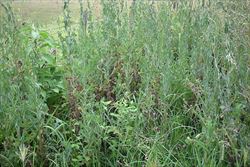
infestation (Photo: Sheldon Navie)
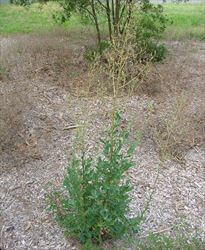
habit in flower (Photo: Sheldon Navie)
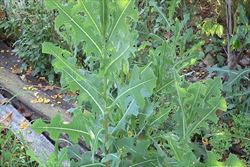
broadly-lobed lower leaves of Lactuca serriola forma serriola (Photo: Sheldon Navie)
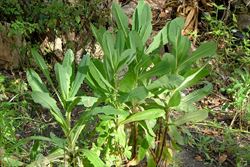
un-lobed lower leaves of Lactuca serriola forma integrifolia (Photo: Sheldon Navie)
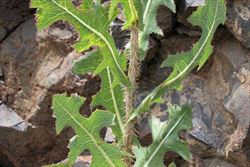
prickly stem and upward-pointing leaves (Photo: Greg Jordan)
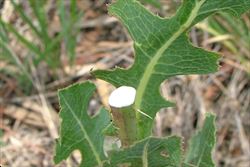
close-up of broken stem showing milky sap (Photo: Sheldon Navie)
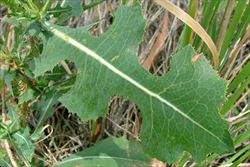
close-up of lobed lower leaf with prominent whitish midrib (Photo: Sheldon Navie)
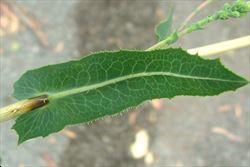
close-up of underside of un-lobed, smaller, upper leaf with finely toothed margins (Photo: Sheldon Navie)
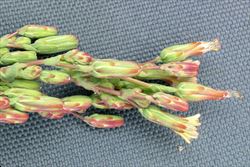
close-up of young flower-heads from side-on showing floral bracts (Photo: Greg Jordan)
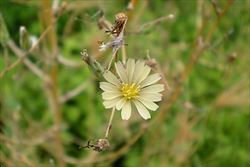
close-up of flower-head (Photo: Sheldon Navie)
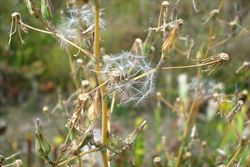
mature seed-heads and seeds (Photo: Sheldon Navie)

close-up of immature seed-head, on the left, and mature seed-head with seeds, on the right (Photo: Sheldon Navie)
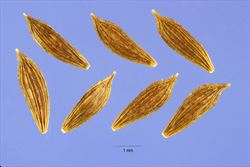
close-up of seeds with hairs removed (Photo: Steve Hurst at USDA PLANTS Database)

young plant (Photo: Sheldon Navie)
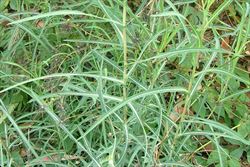
the very similar willow-leaved lettuce (Lactuca saligna), with narrowly-lobed leaves that do not have finely toothed margins (Photo: Sheldon Navie)
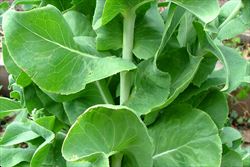
garden lettuce (Lactuca sativa) has broad un-lobed leaves with curly margins (Photo: Sheldon Navie)
Scientific Name
Lactuca serriola L.
Synonyms
Lactuca serriola L. forma serriolaLactuca serriola L. forma integrifolia (Gray) S.D. Prince & R.N. Carter
Family
Asteraceae (Queensland, New South Wales, the ACT, Victoria, Tasmania, Western Australia and the Northern Territory)Compositae (South Australia)
Common Names
China lettuce, compass plant, horse thistle, milk thistle, prickly lettuce, whip thistle, wild lettuce, wild opium
Origin
Native to northern Africa (i.e. Algeria, Egypt, Morocco and Tunisia), Europe, western and central Asia (i.e. Afghanistan, Iran, Iraq, Lebanon, Syria, Turkey, Armenia, Azerbaijan, Georgia, Kazakhstan, Kyrgyzstan, Tajikistan, Turkmenistan, Uzbekistan and most of Russia) and the Indian Sub-continent (i.e. northern India and Pakistan).
Naturalised Distribution
Widely naturalised in Australia, particularly in the eastern and southern parts of the country. It is common and widespread in southern and central Queensland, New South Wales, the ACT, Victoria, South Australia and south-western Western Australia. Less common in Tasmania and the southern parts of the Northern Territory, and occasionally recorded in northern Queensland and other parts of Western Australia.
Widely naturalised other parts of the world, particularly in temperate regions (e.g. throughout the USA and in Hawaii).
Notes
While prickly lettuce (Lactuca serriola) is commonly a weed of agricultural areas and habitation, it is also regarded as an environmental weed in some states and territories (e.g. in Western Australia, Victoria and the Northern Territory).
Prickly lettuce (Lactuca serriola) was ranked as a moderately important environmental weed in the Environmental Weed Strategy of Western Australia, and has been recorded growing in relatively intact native vegetation in this state. In the Northern Territory, it is largely a problem in arid wetlands in southern regions.
Prickly lettuce (Lactuca serriola) is thought to pose a potential threat to one or more vegetation formations in Victoria, and is listed as an common invasive weed in several vegetation types in the north-western parts of this state (i.e. in grassy riverine forest in the Robinvale Plains bioregion and in sedgy riverine forest in the Murray Mallee bioregion). It also appears on local and regional environmental weed lists in other parts of Victoria (e.g. in Colac Oway Shire, Knox City and the Goulburn Broken Catchment).
While not commonly regarded as an environmental weed elsewhere, it does invade natural areas in other states. In South Australia, prickly lettuce (Lactuca serriola) often grows along watercourses and in disturbed bushland and has been recorded in several conservation areas (e.g. Coorong National Park, Kyeema Conservation Park, Brownhill Creek Recreation Park and Onkaparinga National Park). In New South Wales it has been recorded growing in the Ironbark Nature Reserve, on the New England Tablelands, as well as in Paroo-Darling National Park and endangered buloke (Allocasuarina luehmannii) woodlands in south-west of the state.

